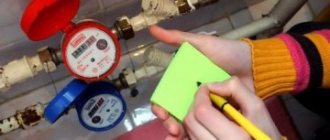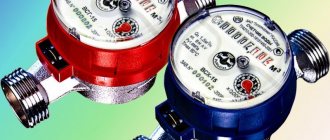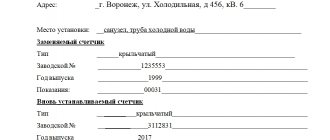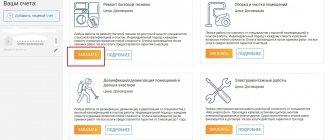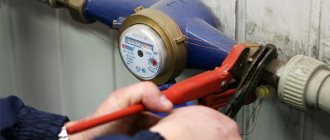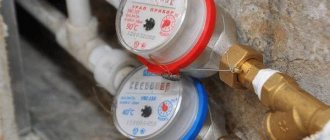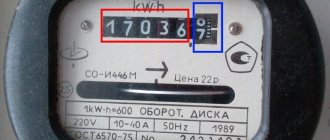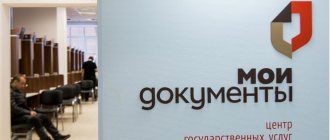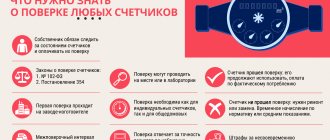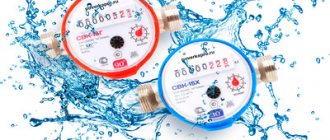Here you will learn:
- Cold water consumption per person without a meter
- Hot water consumption rate
- Advantages and disadvantages of metering devices
- What do you need to pay by the meters?
- How to take readings from the meter
- Calculation of water consumption by meter
- How to pay for water supply
- If the counter is lying
- How to save water in an apartment
Before you pay for water using a meter, you need to find out how profitable it is to install it. Then you need to call a specialist to install and seal the device, and then every month until the 25th, do not forget to submit data on water consumption.
Cold water consumption per person without a meter
It was calculated that on average a person can consume 6.935 cubic meters of cold water per month. What made up this figure? We regularly spend resources on daily needs, without which the concept of a comfortable life is impossible.
To calculate water consumption in general, both hot and cold, we took the average statistical indicators that a person needs daily for the following purposes:
- showering daily – up to 30 liters;
- washing, shaving, etc., which constitutes our daily needs, is 200 liters per week;
- the water that is collected in the toilet cistern is approximately 200 liters per day;
- bathing – 200 liters per week;
- other expenses associated with laundry, cleaning, washing dishes.
There are also losses and other costs of water that may affect the entire residential building. This includes general house needs for cleaning common areas, costs associated with unauthorized connections, leaks in the water supply system of the house and many other factors.
As a result, a decent amount comes in, from which an approximate amount of cold water was extracted. It was adopted as the consumption standard per person per month, if the housing does not have an individual meter.
This is a fairly large amount, which is difficult to cover without even saving water. But utility services have the right to increase it if necessary to cover their costs. At the same time, the upper limit is strictly limited - it should not be more than two standard sizes.
According to the standard, payment for the resource is taken from each person registered in the premises, regardless of whether he actually lives there. This also includes temporarily registered citizens. According to Clause 28 of the Decree of the Government of the Russian Federation dated December 26, 2016 No. 1498 from January 1, 2017.
How to send water meter readings via SMS
First you will need to register your payer code. To do this, send an SMS to number 7377 with the following text: “water kp xxxxxxxxxxx”. Then send the current numbers of your hot and cold water meters to the same number 7377 with the text: “add water xx.x yy.y”, where xx.x are the numbers of the first device, and yy.y are the numbers of the second device.
Access and connection to the service for transmitting water meter data via SMS is provided by the engineering service of your area, for example, Southern Administrative District, South-Western Administrative District, etc.
Hot water consumption rate
The consumption rules for citizens who do not have a meter are as follows: 3,349 cubic meters per person; they are multiplied by the cost for 1 unit, which is 119.09 rubles.
These are approximate prices for hot water supply. In residential dormitories, general house needs are also added, since the shower and kitchen are mostly shared.
About increasing factors
In the absence of individual meters and the technical ability to install them, legislators decided to use increasing factors to calculate fees for all consumed resources. This norm has been introduced since the beginning of 2021 and significantly affects the population’s expenses. On the other hand, this measure encourages citizens to install metering devices.
This applies not only to water meters, but also to meters:
- electricity,
- gas.
Management companies must install common house appliances to control the consumption of resources throughout the house as a whole.
The houses do not have a connection to a centralized hot water supply system
RSO Heat Supply from Petropavlovsk-Kamchatsky went to court with a demand to recover from one of the management companies the debt to pay for utility resources consumed for the maintenance of the common property of the owners of the apartment building. The debt and penalties for late payments amounted to almost 220 thousand rubles.
The management authority refused to pay this debt, since 11 of the 19 houses under its management do not have a separate hot water supply system. Residents take hot water from heating radiators. In such houses it is impossible to provide the hot water supply service to the Kyrgyz Republic, and the company does not agree to pay for it.
The management organization provided documents to the court confirming that only eight houses under its management have a centralized hot water supply system. The company did not dispute the debt for the supply of hot water for the maintenance of common property in these apartment buildings. The subject of consideration by courts of all instances was the question of whether the UO should repay the debt for the CD on SOI, which RSO calculated for it in those houses where there is no such system (case No. A24-1044/2020).
The hot water supplier noted in the court of first instance that an inspection of the intra-house networks of the apartment complex showed the absence of leaks. Since residents of houses take water from the heating system and do not return it there, then this is the selection of coolant as hot water from an open heating system for the provision of public hot water services.
The MA believed that such actions - taking water from heating radiators and heated towel rails - are not evidence of the provision of hot water supply services by the Kyrgyz Republic to SOI.
Should RSO make a recalculation if the volume of CD on SOI is negative?
Advantages and disadvantages of metering devices
Undoubtedly, the purchase of meters, which the Government is trying to lead Russians to by introducing additional coefficients, makes sense and is economically feasible within the same household. The main advantages include:
- Reducing the cost of water. Paying for the resource consumed is much more profitable than paying for water according to standards, which in practice turn out to be too high. Taking into account the current multiplying factor, if you have a meter, the savings are quite significant, since, according to its readings, the numbers are much smaller.
- Water consumption control. The presence of meters helps determine water consumption over a certain period based on instrument readings, which allows you to take measures to reduce it and, as a result, leads to additional savings.
- The number of persons registered in a given living space does not affect the amounts in payment documents. Payment for the device occurs according to the amount of water consumed, regardless of the number of citizens living in the apartment.
Disadvantages of metering devices:
- Price. High-quality meters are quite expensive, and their installation is carried out at the expense of residents.
- Frequent breakdowns. If the meter fails even through no fault of the owner, then he will have to pay for water, according to the standard, throughout the entire period of the malfunction of the device.
Difference in payment with and without a meter
Despite the minor disadvantages, installing a meter is beneficial. The device will pay for itself very quickly. For clarity, we should give an example of charging the amount for the service of providing cold water supply to a family of three living in a comfortable apartment in Kazan:
- No counter. 3*6.73*18.08*1.5 = 547 rubles 55 kopecks.
- With a meter , but subject to water consumption according to the standard by each family member. 20.19*18.08 = 365 rubles 03 kopecks.
The difference is noticeable, and given that such an amount of water is rarely consumed, the benefits of installing a meter become even more tangible. If you calculate hot water consumption per person, then this difference is even higher.
On a note! If there are water heaters, the coefficient does not change.
How to recalculate meter readings
Sometimes there is a need to recalculate meter readings, for example, if charges are not satisfied. To do this, you first need to write a statement to the management company and ask to check the serviceability of the meter and record the current readings. The management specialist must come within 10 working days after the application was submitted.
Sometimes you can even do without a visit from a representative of the service provider; modern technologies make this possible. To do this, you need to write an application in which you must indicate your personal account number and current water meter readings. You must also attach a photo of the meter, on which the numbers on the display must match the readings indicated in the application.
But the answer to the question of whether it is possible to recalculate water costs if data has not been submitted for a certain period of time is not so clear-cut, since in this case several factors must be taken into account, first of all time.
According to the current law, in the absence of meter readings, the first three months of accrual are carried out according to the average monthly readings for the last six months, and then - according to the current standard. Therefore, if the consumer decides to use water meter data again in settlements with the supplier, then he can choose one of two ways:
- accept everything as is and after checking the meter, proceed to pay according to its readings;
- do not accept the situation and initiate a recalculation of payment based on the device readings.
As a rule, the service provider organization is satisfied with both options, but in the second case, they mainly offer redistribution of the “surplus” for future periods, until the meter readings coincide with the accrued volumes of water consumption. But in any case, to solve the problem, you will need to contact the organization with a statement and check it with a representative of the water meter supplier, who must pay a visit no later than 10 working days after the application.
What do you need to pay by the meters?
If water meters are not installed, they must be installed. The installation procedure is quite simple, but if you are not a specialist, in order to save time, it is better to trust those who have performed such work not for the first time.
In the capital, it will not be difficult to find a specialized company that has the appropriate certificate, and you will not have problems with the engineering service when registering devices. Competition in the installation sector of water meters in Moscow is quite high, there are many offers, the price level does not differ much, and the cost of installation will not be excessive.
How to transmit water meter readings by phone
To do this, you need to call the Unified Service Service in Moscow by phone number and say that you want to transfer readings from individual metering devices. Also, be prepared to be asked for the following information:
- FULL NAME;
- address;
- payer code (it is indicated in the housing and communal services payment receipt);
- serial numbers of water meters (they can be found on the devices themselves or in the contract).
Testimony by telephone is accepted every weekday from 8.00 to 20.00, during the last ten days of the month.
How to take readings from the meter
The water meter has eight rollers with numbers.
Five black and three red. For example, initially the counter showed the following data: 00000174. Here 174 is the number of liters of water used. As you know, readings must be taken in cubic meters, so it is too early to transmit them. In other words, the readings from the meter are taken based on the first five digits, so you can wait a month.
A month later, look again - the readings are already different: 00001174. In this case, they can already be taken, because there are more than three digits. It turns out that you use a little more than 1 cubic meter of water per month. When sending indicators, the amount is rounded, you pay only per cubic meter. Another month later we see on the water meter: 00012566. Now it turns out that 12 cubic meters were used. Subtract 12-1=11. This month you pay for 11 cubic meters of water.
Position of the Ministry of Construction of the Russian Federation
Let us recall that the Ministry of Construction of the Russian Federation first indicated that: “in the case of independent production of utility services for heating and hot water supply by the contractor between the owners of premises in the house and the resource supplying organization, the contract for the provision of utility services, provided for in Article 157.2 of the Housing Code of the Russian Federation, cannot be concluded, since in this In this case, the resource supplying organization provides a utility resource for the independent production of a utility service and is not itself a producer of such a service” (Letter of the Ministry of Construction of Russia dated 05/07/2018 No. 20237-OG/04).
Then this letter was withdrawn (Letter of the Ministry of Construction of Russia dated November 12, 2018 No. 45276-OO/04).
A little later, the Ministry of Construction of the Russian Federation spoke as follows:
- The Housing Code of the Russian Federation does not establish exceptions regarding the transition to direct contracts, and therefore the transition to direct contracts in accordance with Article 157.2 of the Housing Code of the Russian Federation for MKD, in which the preparation of hot water is carried out using common property, is possible (Letter of the Ministry of Construction of Russia dated 02/04/2019 No. 3080 -OO/06).
- to switch to direct contracts with the resource supplying organization in the apartment building, in which hot water is prepared using equipment located in the house and related to the common property of the house, the owners have the right to decide to conclude with the resource supplying organizations: a heat supply agreement in order to provide them with communal heat supply services ( for the preparation of hot water) and a cold water supply agreement in order to provide them with public services for cold water supply (including for the preparation of hot water). Such public services are named in paragraph 55 of Rules No. 354 and in accordance with Part 1 of Article 7 of the RF Housing Code (analogy of the law) can be provided to consumers of utility services by a resource supplying organization in the absence of the person managing the apartment building (Article 164 of the RF Housing Code), or in the period up to conclusion by the person managing the apartment building of a resource supply agreement with a resource supplying organization (Part 9 of Article 157.2 of the RF Housing Code) (Letter of the Ministry of Construction of Russia dated January 22, 2019 No. 1324-OO/06).
In the example with which the article began, the management company also referred to clause 55 of Rules No. 354, but the court did not like this analogy, and it simply stated that the rule applies to cases where heating equipment is installed directly in a residential premises.
As another negative example, we can point out the Resolution of the Arbitration Court of the North-Western District dated September 26, 2019 in case No. A56 - 134319/2018. There, the court rejected a partnership from the Leningrad region's claim to recognize the hot water supply and heating agreement concluded for an indefinite period between the RSO and all owners of the apartment building.
Calculation of water consumption by meter
Water meters count the volume of water flowing through them over the entire period of operation.
Therefore, water consumption for the billing period is calculated by simply subtracting the numbers of previous readings from the numbers of new readings.
For example, your cold water meter measured 10523.849 (rounded to 10524 m3).
Last month you took readings of 10509.691 (rounded to 10510 m3).
Subtract 10510 from 10524 last month, we get 14 m3 of cold water.
We multiply the volume of consumption by the tariff 14x38.70 = 541.8 rubles.
This is exactly how much you will have to pay for water according to your receipt.
General house needs
In the Rules for the Provision of Public Utilities, outlined in Decree of the Government of the Russian Federation No. 354, in addition to payment for the consumption of cold and hot water on apartment meters, the category “common house needs” (CHN) is prescribed, for which payment is also charged.
Water consumption for one water pumping station consists of:
- watering front gardens and lawns near the house;
- washing staircases, common areas in entrances;
- waste of water during repairs;
- water consumption during repair of heating systems.
Tariffs and consumption standards for general household needs are approved by regional authorities and published both in official sources and on the websites of management companies.
If apartment buildings are equipped with individual and common building water meters, then the ODN is calculated as the difference between the flow rate calculated by the common building meter and the flow rate for all individual water meters.
The distribution of ODN expenses among residents is proportional to the area of their apartments.
Since 2021, payment for one-time tax has been moved in receipts from the “utilities” column.
DHW does not have a separate connection to the pipelines of the open heating system of the house
The court of first instance, resolving the dispute between the UO and the RSO, indicated that the possibility of charging for the consumed CR on the SOI depends on the design features of the apartment building.
Hot water supply in accordance with paragraphs. “b” clause 4 of RF PP No. 354 is the supply of hot water supplied through centralized hot water networks and in-house engineering systems to residential and non-residential premises in an apartment building, as well as to premises included in the common property.
By virtue of Part 19.1 of Art. 2 of Federal Law No. 190-FZ of July 27, 2010, an open heat supply or hot water supply system is understood as a technologically connected complex of engineering structures designed for heat supply and hot water supply by extracting hot water from the heating network. At the same time, DHW in open heating systems must have a separate connection to the return and supply pipelines, which makes it possible to regulate and maintain the water temperature.
The court of first instance, when considering case No. A24-1044/2020, indicated that its important circumstances include the presence in the disputed apartment buildings of a separate hot water system connected to the supply and return pipelines of the heating system.
RSO insisted that the apartment buildings are connected to centralized networks: the technical passports of these houses contain information about the presence of bathrooms with hot water supply from the central network. But the management office indicated that in fact there is no connection of houses to hot water supply systems. She provided reports indicating that the in-house hot water supply networks have been inoperative since the moment the apartment buildings were put into operation.
Based on this, the court noted: in the disputed apartment buildings there is no centralized hot water supply, this implies that there is no hot water supply service for the Kyrgyz Republic at the SOI. During the non-heating period, the judge pointed out, residents of the house have no way to get hot water at all. According to the court, the extraction of hot water from the heating system cannot be recognized as evidence of consumption of the communal resource “hot water” in the house during the maintenance of common property.
The court of first instance decided that these facts prove: in 11 houses under the defendant’s management there are no hot water services from the Kyrgyz Republic at SOI, therefore RSO does not have the right to demand payment from the company for it. As a result, the court confirmed that the management organization owes the hot water supplier only 62 thousand rubles for the KR on SOI for eight houses with a centralized hot water system and only 83 rubles in penalties.
When the management authority does not have the right to refuse to pay the Kyrgyz Republic for the waste water disposal system
How to pay for water supply
It is necessary to pay for water supply and sewerage on time. In most cases, this requires taking and submitting meter readings, waiting for a receipt and paying for services.
When to submit data
Existing legislation does not contain deadlines for the transfer of data on housing and communal services that are strictly tied to the dates of the month. The “Rules for the Provision of Utility Services” indicate that these terms must be defined in the contract.
Therefore, the period for receiving information for calculating the cost of consumed resources and generating a receipt is chosen by the water supply organization or the company managing the apartment building.
Typically, the deadline for submitting data from water meters is limited to the 18th-25th of the current month. But it is better to find out information about this period from the resource supply organization
Synchronous submission of information is needed primarily for the correct calculation of indicators that will go into the “SOI” column. The deadline for submitting data for payment of utility services (including water) for December and April may be moved to earlier dates due to the New Year and May holidays.
There are many ways to provide meter readings and they depend on the company that generates the receipts.
The following types of communication are usually available and popular:
- phone call;
- SMS with a certain sequence of information;
- filling out the form via the Internet.
If a water consumer does not provide information on metering devices on time, then the average indicators for the last 6 months will be automatically calculated. If the owner does not provide data within 6 months, then he may be transferred to standardized payment, which, as a rule, significantly exceeds actual consumption.
How to pay
You can pay for water supply according to meter readings via the Internet, at a bank or directly at the cash desk of a management or resource supply company.
Paying utility bills at the bank on the last day, as a rule, is accompanied by a long wait for your turn. It's better to do it earlier or choose another method
If the consumer has a bank card with the ability to make online payments, the easiest way will be to pay for housing and communal services via the Internet.
There are several sites through which you can perform this operation:
- unified information settlement center (UISC);
- state portal services (GIS housing and communal services);
- website of the bank that issued the card.
Everywhere you will need to register. You also need to know not only your address, but also your personal account number. After filling out all the data, the user will be transferred to the bank’s website, where he will need to complete the online payment procedure.
If this method is complex or unusual, and the bank branch is close, then you can go there with a receipt. You can make a payment either at the cash register (the bank may charge a commission) or at an ATM.
Sometimes, especially in small villages and towns where there is no bank, payment can be made at the post office or at the village council.
How to transmit water meter readings via a mobile application
- Open Google Play for Android or App Store for iOS.
- In the search, enter the words: “State.
- Select and download any of these apps to your phone.
- Register in the application by filling out your profile.
- Find the Housing icon, then click on Meter Readings.
- Click on the “Enter readings” button and enter the numbers for the last month, or for the month for which you want to transfer information.
- Now don't forget to click "Save".
- Your meter data has been sent.
If the counter is lying
To check, the meter is dismantled and taken to the laboratory
If you notice that the meter is showing false information, you should check it. The verification will be carried out at your expense. If the meter is under warranty, then the certified company that sold it will pay. During this time, you will pay for water according to your average monthly consumption. After the inspection is completed, the water meter is repaired or replaced. If you overpaid, a recalculation occurs and the overpayment amount is returned to you.
Now about the cause of the malfunction. Your guilt is determined if the seal on the meter is damaged, the glass is broken, or the arrows are missing, if a scheduled check was not done. Then you will face a fine.
Checking the correctness of the readings
Expert opinion
Mironova Anna Sergeevna
Generalist lawyer. Specializes in family issues, civil, criminal and housing law
The meter may become unusable over time. Also, it often shows incorrect data ahead of schedule. If the consumer notices that he has begun to pay for water in significantly larger or smaller amounts, then he is recommended to check the correct operation of the water meter.
You need to take a 10-liter bucket and fill it to the brim with water. Then it must be drained. Fill the bucket with water two more times. If the red numbers on the device show a consumption of 30 liters, then it is working correctly. If the readings are less than or more than 30, then the water meter needs to be repaired or replaced. In this case, the consumer must call housing and communal services representatives for an unscheduled inspection. Based on its results, repairs or complete replacement of the water meter will be carried out at the expense of the consumer.
How to save water in an apartment
To save money, be sure to consider:
- Are meters installed for hot and cold water (they are necessary for obvious savings);
- The number of registered citizens in the residential premises (simply residents are not taken into account);
- What water procedures are performed and how often (laundry, washing, including dishes).
These criteria help to calculate the benefits of using or not using metering devices. The situation is that several years ago it was not profitable to connect metering devices. Now prices according to various standards have been raised, and therefore people have begun to think more about saving.
Let's celebrate! Readings are taken according to the following scheme: the numbers indicated on the meter are written off; there must also be previous readings from which the current ones are subtracted. This creates a digital combination that must be paid and submitted to the utility.
Incoming receipts show the cost for 1 unit of consumption and the amount consumed per month. The amount is calculated automatically through the program. If an employee of the management company made a mistake in the calculations and indicated incorrect numbers on the payment slip, then before making the next payment, you must contact them to correct such an error.
Hot water meter with temperature sensor
According to the rules enshrined in the same Decree of the Government of the Russian Federation No. 354, water with a temperature of less than 40 degrees Celsius is considered cold and is paid at cold water supply tariffs. In cases of unstable heating or high heat losses during the transportation of hot water, a person receives water with a low temperature, which leads to an unjustified increase in costs.
The operation of a hot water meter with a temperature sensor is based not only on calculating the volume of flowing water, but also on periodically measuring its temperature.
The electronics of such a meter are configured for automatic calculation, recalculating the actual volume of consumption taking into account reduction factors depending on the water temperature.
The digital display of the meter with a temperature sensor shows:
- consumption;
- temperature;
- and volume adjusted by reduction factors.
With proper verification and operation of such a meter, a reduced value is transmitted to the management company as indications for calculating the volume of consumption.
Using these values, the management company calculates the cost of hot water in the receipt that the tenant pays.
It is not profitable for management companies to use meters with a temperature sensor, so they are reluctant to agree to their installation. But the operation of such meters is permitted by law. It is enough that the water meter model is certified and has a technical passport.
The price of meters with a temperature sensor ranges from 2500 to 7500 rubles, installation costs another 1000–2000 rubles. If problems with hot water temperature occur frequently, then such a meter will pay for itself within 1–2 years.
Equipment and accessories
- To use water economically, you need to develop the habit of monitoring water consumption and reducing its wasteful runoff.
- The most widely used methods for saving water are aerators, special attachments for faucets and shower heads that split the flow of water into small streams and saturate it with air.
- Toilet cisterns are equipped with trigger mechanisms with full and incomplete flush.
- According to users' calculations, in some cases it is more profitable to install a water heater and heat cold water than to use hot water supply.
- If there are many residents in the house and a large amount of dirty dishes are often collected, then instead of washing dishes by hand, it is more economical to use a dishwasher. The situation is similar with the washing machine. To save water, it is better to load it less often, but completely, than to often wash one or two items at a time.
- In addition to the equipment listed, residents use homemade modifications to the water supply in the apartment and devices of the “cunning inventions” type.
The most convenient way to pay is through Internet banking, as you can set up regular payment templates there. Paying for water and other utilities using templates saves your time.
Payment Methods
Common methods of paying for water are: an independent visit by the consumer to a management company or payment center and Internet banking. In both cases, receipts will be required to pay for water meters.
You can also pay for housing and communal services through bank terminals. The most common method of transferring funds is by directly contacting the post office or bank.
In the management company
Citizens can pay for water services at the EIRC. This organization is a single center that accepts money for water supply services. You must first call the billing center and provide the dispatcher with the data from the meters. You can also send information to the EIRC by mail.
The consumer also has the opportunity to visit the center in person. His address and telephone number are always indicated on receipts. At the center, the consumer can provide an employee with readings from the devices, make a note about this in the appropriate journal and pay for the water supply service through the cash register. When paying, he is given a receipt confirming that the money has been transferred.
How to pay for water by meter via the Internet
This option does not involve visiting the EIRC. It is enough for the consumer to have access to the Internet. The easiest way to pay for housing and communal services is Internet banking. Through your Sberbank Online personal account, you can pay for water at the meter according to the following scheme:
- Go to sberbank.ru. Select the “Sberbank Online” option on the website.
- Log in to online banking by entering your username and password.
- In Sberbank Online, click on “Transfers and Payments”.
- In the window that loads, select “Housing and Communal Services”.
- Click on the “Water supply” item in the line that appears.
- Indicate in the line the organization providing the service and the region where it is located.
- Write the type of service provided.
- Enter the account number from which money is supposed to be written off.
- Specify the card from which funds will be debited.
- Click on “Pay”.
- Receive a password from the bank on your mobile phone. With its help, the user will confirm his operation. The password must be specified in a special window. The user will then receive confirmation in the form of an email receipt.
It is possible to pay water bills on the State Services website. You must first register on the portal by providing your passport details along with your TIN. As a result, the user will have a personal account created. To enter it you will also need to enter a login with a password.
After gaining access to your personal account, you need to go to the tab called “Payment for services”. Next you will need to click on “Accruals”. In this section, you must fill in all the fields, indicating the data from the meters, the company where the money will be transferred, and the region where it is located. The system will generate a statement. Using it, the user will be able to pay water bills.
Funds transferred for services via the Internet are usually credited within a few seconds. Sometimes the transfer can take up to 3 days.
